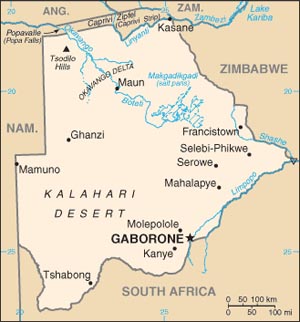Geography
Area: 582,000 sq. km. (224,710 sq. mi.), about the size of Texas.
Cities (2001 census): Capital–Gaborone (pronounced ha-bo-ro-neh), pop. 186,007. Other towns–Francistown (83,023), Selebi-Phikwe (49,849), Molepolole (54,561), Kanye (40,628), Serowe (42,444), Mahalapye (39,719), Lobatse (29,689), Maun (43,776), Mochudi (36,962).
Terrain: Desert and savanna.
Climate: Mostly subtropical.
People
Nationality: Noun and adjective–Motswana (sing.), Batswana (pl.).
Population (est.): 1.84 million.
Annual population growth rate (2008): 1.434%.
Ethnic groups: Tswana 79%; Kalanga 11%; Kgalagadi, Herero, Bayeyi, Hambukush, Basarwa (“San”), Khoi, whites 10%.
Religions: Christianity 70%, none 20%, indigenous beliefs 6%, other 4%.
Languages: English (official), Setswana, Ikalanga.
Education: Adult literacy–81%.
Health (2008): Life expectancy–50.6 years. Infant mortality rate–44.01/1,000.
Work force (2005-2006 est.): 548,600 employed; total including unemployed, 651,500.
Government
Type: Republic, parliamentary democracy.
Independence: September 30, 1966.
Constitution: March 1965.
Branches: Executive–president (chief of state and head of government), cabinet. Legislative–popularly elected National Assembly; advisory House of Chiefs. Judicial–High Court, Court of Appeal, local and customary courts, industrial labor court.
Administrative subdivisions: Five town councils and nine district councils.
Major political parties: Botswana Democratic Party (BDP) 45 seats, Botswana Movement for Democracy (BMD) 6 seats, Botswana National Front (BNF) 5 seats, Botswana Congress Party (BCP)/Botswana Alliance Movement (BAM) 5 seats.
Suffrage: Universal at 18.
Economy
Nominal GDP (2009 est.): $12.0 billion.
Real GDP growth rate (2009): -3.7%.
Per capita nominal GDP (2009 est.): $6,200.
Natural resources: Diamonds, copper, nickel, coal, soda ash, salt, gold, potash.
Agriculture (2% of real GDP, 2008): Products–livestock, sorghum, white maize, millet, cowpeas, beans.
Industry: Types–mining (40% of real GDP, 2008): diamonds, copper, nickel, coal; tourism, textiles, construction, beef processing, chemical products production, food and beverage production.
Trade (2008): Exports–$5.127 billion f.o.b.: diamonds, nickel, copper, meat products, textiles, hides, skins, and soda ash. Partners–EU, South Africa. Imports–$3.931 billion f.o.b.: machinery, transport equipment, manufactured goods, food, chemicals, fuels. Major suppliers–South Africa, EU, and U.S.










